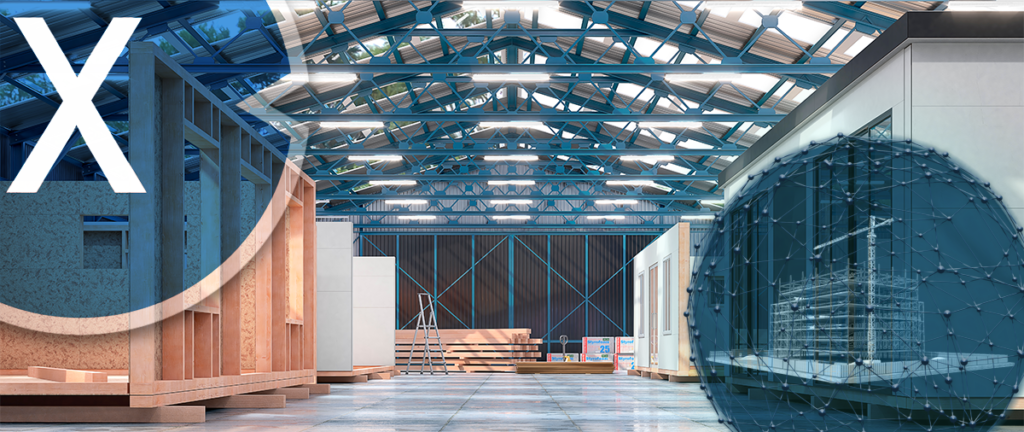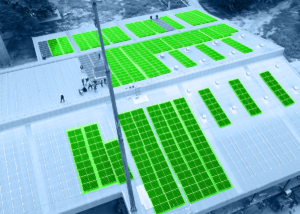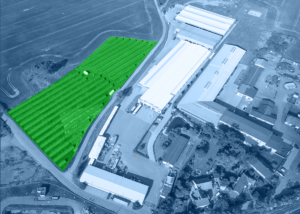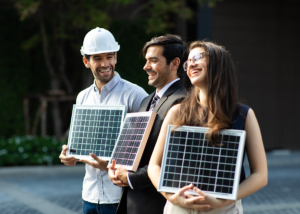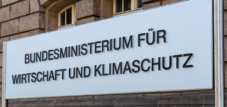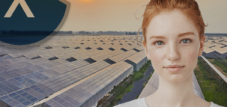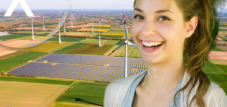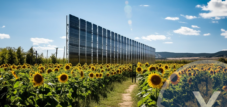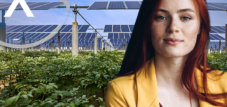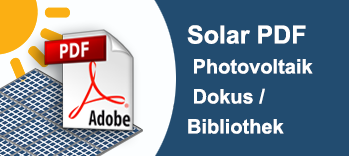Solar package 1: Balcony solar & parking systems, commercial properties, open space systems, solar parks and agri-photovoltaics
Language selection 📢
Published on: August 22, 2023 / update from: August 22, 2023 - Author: Konrad Wolfenstein

Solar package I: Balcony solar systems, commercial properties, open-air systems, solar parks and agri-photovoltaics - Image: Xpert.Digital
Federal Cabinet approves Solar Package I for more solar power and less bureaucracy 🌞🔋
In a significant step, the federal government has adopted the Solar Package I, which includes a series of measures to reduce bureaucracy and accelerate the construction and operation of photovoltaic systems. The aim of the legislation is to make it easier to expand photovoltaic systems and improve access to solar energy for citizens and companies.
Simplified construction of PV systems on the balcony
A notable change concerns the installation of PV systems on the balcony. The Solar Package I makes this faster and easier for citizens. This strengthens access to decentralized energy generation.
Photovoltaics made easier for citizens and companies
Solar Package I aims to facilitate and unbureaucratic installation of photovoltaics (PV) on roofs and in open spaces. This step is of great importance for the success of the energy transition in Germany.
Climate neutrality and renewable energies
Germany is pursuing the goal of becoming climate-neutral by 2045. Reducing greenhouse gas emissions in the electricity sector by 2035 is a significant step on this path. The increased use of renewable energies, particularly solar energy, plays a central role.
Promoting the expansion of renewable energies
The increasing demand for electricity, caused by electromobility and green heating, among other things, requires an increased expansion of renewable energies. Solar Package I supports this expansion by accelerating the construction of PV systems on roofs and in open spaces.
Optimization of the overall energy supply system
The legislative package and Solar Package I not only pursue the expansion of PV systems, but also the optimization of the entire energy supply system. The aim is to make energy production more sustainable and efficient.
Strengthening solar energy in the energy transition
Solar energy plays a key role in implementing the energy transition. The Solar Package I helps to promote the use of solar energy and support Germany on the path to climate neutrality.
📣 Similar topics
- Solar package I: The federal government is relying on more solar power and less bureaucracy
- Renewable energies in focus: Solar package I accelerates the expansion of photovoltaics
- Advancing the energy transition: Solar Package I makes photovoltaic installation easier
- Sustainable energy: Solar package I paves the way for a climate-neutral future
- Decentralized energy generation: Solar Package I promotes photovoltaic projects
✨ Summary
- 📦 Federal government approves Solar Package I for photovoltaic expansion
- 🏠 Simplified PV systems on the balcony
- 🌞 De-bureaucratization and acceleration of photovoltaics
- 🌍 Contribution to the energy transition and climate neutrality by 2045
- 🔌 Solar package I promotes renewable energies and expansion
- 💡 Optimization of the energy supply system through a draft law
- 🚀 Solar energy as the key to sustainable energy production
#️⃣ Hashtags: #SolarpaketI #Photovoltaics #Energy Transition #RenewableEnergy #Climate Neutrality
🌞 Maximizing solar energy: A look at the federal government's solar package 🌞
In today's world, when climate change is a constant challenge, the German federal government has taken measures to promote the expansion of renewable energies. Solar Package I, recently unveiled, is at the heart of these efforts. In this section, we will go into detail about the different aspects of this solar package and how it paves the way for a more sustainable energy future.
Promotion of solar energy
The federal government's solar package includes financial incentives for the installation of solar systems. These subsidies are aimed at lowering the hurdles for private households and companies that want to switch to renewable energy sources. Here are some important aspects:
- 🌞 Photovoltaic systems for homes: The solar package makes it easier for homeowners to access solar energy. Subsidies and tax breaks make the installation of photovoltaic systems more attractive.
- 🏢 Corporate Applications: Companies are encouraged to switch to solar energy to reduce their carbon footprint. The Solar Package offers financial incentives and advisory services for companies that want to install solar systems on their buildings.
Modernization of energy networks
The integration of renewable energy also requires modernization of energy networks to ensure the efficiency and stability of the power grid:
- ⚡ Smart Grids: The Solar Package promotes the development of smart grid infrastructures to facilitate the integration of solar and other renewable energies. This ensures smooth energy distribution.
- 💡 Storage technologies: Energy storage is crucial for storing excess solar energy for times when there is no sunlight. The solar package supports the research and development of energy storage technologies.
Education and awareness
In order to make the advantages of solar energy widely known, the federal government is relying on education and awareness-raising:
- 📚 Educational programs: The solar package includes educational initiatives designed to educate students about renewable energy and its importance for the environment.
- 🌐 Information campaigns: The general public is informed about the benefits of solar energy through targeted information campaigns.
Research and innovation
In order to drive progress in solar technology, the federal government is investing in research and innovation:
- 🔬 Research funding: The solar package offers financial support for research projects in the field of solar technology. This promotes new developments and innovations.
- 🌱 Start-up support: Young companies and start-ups in the field of renewable energies receive targeted support to bring innovative ideas to market maturity.
📣 Similar topics
The German federal government's Solar Package I marks a significant step towards a sustainable energy future. The diverse measures, from financial support to modernizing energy networks, demonstrate the government's commitment to renewable energy. By supporting and developing this initiative, we can make a positive change for our environment and future generations.
- The federal government's solar package: Renewable energies for a sustainable future
- Solar energy in Germany: How the solar package is driving change
- Into the future with solar power: The federal government's comprehensive solar package
- Promoting solar energy: A look at the groundbreaking solar package
- Sustainable energy: The solar package and its effects on Germany's energy transition
Plan your solar system for the most common applications conveniently online with our solar system planner!
With our user-friendly solar system planner you can plan your individual solar system online. Whether you need a solar system for your home, your business or for agricultural purposes, our planner offers you the opportunity to take your specific requirements into account and develop a tailor-made solution.
The planning process is simple and intuitive. You simply enter relevant information. Our planner takes this information into account and creates a tailor-made solar system that meets your needs. You can try out different options and configurations to find the optimal solar system for your application.
Additionally, you can save your plan to review later or share with others. Our customer service team is also available to answer your questions and provide support to ensure your solar system is optimally planned.
Use our solar system planner to plan your individual solar system for the most common applications and advance the transition to clean energy. Start now and take an important step towards sustainability and energy independence!

The solar system planner for the most common applications: Plan the solar system online here - Image: Xpert.Digital
More about it here:
📣 Energy-related renovation and new construction, consulting, planning and implementation for industry, retail and municipalities
Our experienced team will support you in optimizing your buildings to reduce energy consumption and promote sustainable energy use with photovoltaics. We analyze your individual needs and create tailor-made concepts that make sense both economically and ecologically. Regardless of whether it is about the energy-efficient renovation of existing buildings or the construction of new energy-efficient structures, we are at your side. Industrial facilities, retail buildings and municipal facilities can reduce their energy costs and reduce environmental impact while improving the comfort and efficiency of their buildings through our tailored solutions.
👨🏻 👩🏻 👴🏻 👵🏻 Energy-saving renovation and new construction, advice, planning and implementation for private households
We offer comprehensive support for private households in the energy-efficient renovation and construction of new buildings with photovoltaics. Our experienced team is at your side to help you advise, plan and implement your sustainable energy solutions. We analyze your energy consumption, identify savings potential and develop tailor-made concepts to improve your energy efficiency. From improving building insulation to installing energy-efficient windows and doors to installing photovoltaic and solar systems - we accompany you step by step to make your home more energy efficient and environmentally friendly. Trust in our expertise and benefit from the numerous advantages that energy renovation and the use of renewable energies offer you. Together we will create a sustainable future for your home.
🌞 The Solar Package I: Advancing photovoltaics in Germany 🌞
The Federal Government has launched an initiative with the “Solarpaket I” to simplify and accelerate the installation of photovoltaic systems (PV systems). This measure aims to optimize the process for citizens, citizens and companies and reduce bureaucratic hurdles. Germany is thus in accordance with the ambitious goal of achieving climate neutrality by 2045, which requires a significant reduction in greenhouse gas emissions from the energy sector by 2035. In order to achieve these goals, the government increasingly relies on the expansion of renewable energy sources, with solar energy playing a crucial role in covering the increasing electricity requirements, especially for heating and electric vehicles.
Accelerated PV installation and optimization of the energy supply system
One focus of the legislation, including the “solar package I”, is on the acceleration of the installation of PV systems on roofs and open spaces as well as on optimizing the entire energy supply system. This package marks the first phase of the photovoltaic strategy, which was developed in cooperation with industry, federal states and parliamentary groups and presented in May 2023. The increase in photovoltaic capacity in Germany is clearly visible: In the first half of 2023, almost 6,000 megawatts were added, which previously exceeded previous records between 2010 and 2012. This capacity could supply 3.5 million households annually. The forecast shows a more than three-time expansion by 2026, where 22 gigawatts are to be achieved, evenly divided between open spaces and roofs, in accordance with the new Renewable Energy Sources Act (EEG).
Simplified installation of balcony PV systems
The “Solar package I” aims to simplify the installation of PV systems on balconies by eliminating the previous registration requirements with the network operator and the market master data register is optimized. Balcony PV systems are freed from the obligation to measure bidirection, and systems with higher capacity benefit from simplified registration. This regulation includes systems with a total output of up to 2 kilowatts and an inverter with a capacity of 800 voltampers. Standardization efforts are underway to use conventional Schuko plugs.
Community care in apartment buildings
Multi -family houses can accept the “Community Building Care” approach, in which solar power is distributed directly to the tenants without involving the general power grid. Guidelines for billing and timely notifications in the event of interruptions ensure the access of the tenants to be supplemented to additional tariffs for additional electricity requirements. Improvements in consumer protection are planned together with industry. The area of application of tenant electricity also extends to commercial buildings and adjacent structures such as garages, with simplified rules enable the summary of systems.
Commercial PV systems and surplus feed-in
Commercial businesses with PV systems over 100 kilowatts can now feed excess electricity into the network operator free of charge and without marketing costs. This promotes self-consumption and better use of roof space. In addition, a new certificate requirement applies to systems with a capacity of over 270 kilowatts or 500 kilowatts. Comprehensive regulations also address sustainable ground-mounted solar projects, emphasizing dual-use approaches such as the integration of agricultural use and solar PV panels (agri-PV). Protected areas in accordance with the Federal Nature Conservation Act remain excluded from this. The promotion of PV systems on sealed areas such as parking lots will be introduced, with dedicated auction segments and individual caps.
The “solar package I” is a crucial step to promote the expansion of photovoltaics in Germany. The measures to simplify the installation, promotion of self -consumption and use of various areas will help to make the energy supply more sustainable and climate -friendly. Germany thus sets a strong sign in the fight against climate change and creates the basis for a sustainable energy infrastructure.
📣 Photovoltaic open-space systems and solar parks for industry, retail and municipalities
Everything from a single source, specially designed for solar solutions for large parking areas. You refinance or counterfinance into the future with your own electricity generation.
🎯 For investors
Advice and planning including a non-binding cost estimate. We bring you together with strong photovoltaic partners.
More and more photovoltaics on roofs and open spaces
Photovoltaic systems in Germany: A growth trend with great energy!
The energy industry in Germany is currently experiencing a remarkable revolution - a continuous increase in the installation of photovoltaic systems on roofs and open spaces. In the first half of 2023, with an impressive capacity of almost 6,000 megawatts, more power was added than ever before in the record years 2010 to 2012. This represents an enormous amount of energy coming from renewable sources and making a significant contribution to reducing CO2 emissions. It's more than just a change in energy supply; it is a sign of change towards a more sustainable future.
🌞 Sunny prospects for the energy sector
The current trend shows just a taste of what the future will bring. From 2026 onwards, the expansion of photovoltaic systems is expected to multiply and reach more than three times the current capacity, an impressive 22 gigawatts. This expansion will take place roughly half on open spaces and the other half on rooftop systems. This highlights the versatility and ingenuity of the German energy industry, which is using various options to increase the share of renewable energy.
💡 Energy for millions of households
The impact of this growth trend cannot be overlooked. Thanks to these advanced photovoltaic systems, up to 3.5 million households could be supplied with clean solar power every year. This will not only lead to a reduction in dependence on fossil fuels, but also to greater decentralization of energy production. Households can increasingly take their energy supply into their own hands and actively contribute to the energy transition.
🌍 Sustainability in focus
The increasing investment in photovoltaic systems on roofs and open spaces underlines the growing awareness of environmental protection and sustainability. Germany is once again positioning itself as a pioneer in the field of renewable energies and setting an inspiring example for other countries. This development is not only a step towards climate neutrality, but also a step towards a better and more sustainable future for future generations.
🚀 Future potential and opportunities
The expansion of photovoltaic systems not only offers environmentally friendly advantages, but also opens up new business opportunities and jobs. Companies in the renewable energy sector can benefit from this growing market and develop innovative solutions to further improve the efficiency and performance of their systems. At the same time, new jobs are being created in the planning, installation and maintenance of photovoltaic systems, which stimulates the economy and enriches the job market.
🔮 A look into the future of energy
The future development of photovoltaic systems in Germany promises exciting changes. Increased use of solar energy will not only reduce energy costs for consumers, but also reduce dependence on imported fossil fuels. This is a significant step towards energy self-sufficiency and a sustainable, low-carbon energy supply.
📣 Similar topics
- 🌞 Energy industry in transition: photovoltaics on the rise
- 🏡 Roofs and open spaces as energy sources: photovoltaic boom in Germany
- 💡 Solar power for millions: The rise of photovoltaic systems
- 🌍 Sustainable future: Photovoltaic systems set an example
- 🔮 The future of energy: Photovoltaics as the key to the energy transition
- 🚀 Innovative and environmentally friendly: Germany's path to renewable energy
- 📈 Growth without limits: Photovoltaic systems are conquering the market
- 🌱 Green energy, within reach: photovoltaic systems for sustainable households
- 🏆 Breaking records, shaping the future: Germany's photovoltaic trend
- ⚡ Bright prospects: The triumph of photovoltaics in Germany
#️⃣ Hashtags: #RenewableEnergy #Photovoltaics #Sustainability #Energy Transition #FutureEnergy
🌞 The future of balcony PV systems: Easier and more efficient 🌞
In a welcome development, the commissioning of photovoltaic systems on the balcony will be made much easier for citizens. This not only has a positive impact on the environment, but also on your wallet. The legislative package that made this progress possible resulted from a close exchange with industry experts as part of a practical check on photovoltaics. The aim was to reduce hurdles and bureaucracy and thus speed up and simplify the installation of balcony PV systems.
⚡️ The key innovations at a glance ⚡️
- Uncomplicated commissioning: One of the most significant changes is the abolition of the previous registration with the network operator for balcony PV systems. This speeds up the process significantly and makes it less complex. In the future, it will be enough to register in the market master data register with a few, easy-to-understand information.
- Don't be afraid of digital electricity meters: There is no obligation to install a bidirectional meter. Existing Ferraris meters can continue to be used for the time being. These meters simply rotate backwards when electricity is fed in, reducing costs for consumers.
- Higher performance: The next positive change concerns the performance of balcony PV systems. Systems with a total output of up to 2 kilowatts and an inverter output of up to 800 volt amperes can now be registered more easily.
- Easier installation: The aim is to use a conventional Schuko plug for balcony PV systems in the future. This would make installation much easier and is a key aim of the legislative package. However, it is important to note that a standard still needs to be developed in collaboration with relevant associations.
🏡 The benefits for consumers 🏡
These advances mean a number of benefits for citizens interested in installing balcony PV systems. Aside from the obvious environmental benefits of using renewable energy sources, there are also financial incentives. Simplifying the registration process and the ability to continue using existing meters result in cost savings during installation. This in turn reduces electricity costs, which is of great benefit to consumers.
🌐 Outlook and conclusion 🌐
The future of energy production on balconies looks promising. Thanks to easier commissioning, higher performance and simplified installation, more people will have the opportunity to switch to renewable energy. This is a significant step towards sustainability and cost efficiency.
📣 Similar topics
- 🌞 Easy commissioning: New possibilities for balcony PV systems
- ⚡️ Don't worry about electricity meters: The regulations for meter use
- 🏡 Consumer benefits: Cost savings and environmental protection through balcony PV
- 🌐 Future prospects: How the innovations influence the energy transition
- 💡 Installation made easy: Schuko plug and its meaning
#️⃣ Hashtags: #BalconyPV #RenewableEnergy #Sustainability #EnergyEfficiency #Environmental Protection
🗒️ The future of solar power in apartment buildings: Community building supply
The introduction of the “community building supply” is paved for the direct connection of roof solar power in apartment buildings. This means that the solar power generated no longer has to be fed into the public network, but can be made available directly to tenants. This innovation brings numerous advantages, from more efficient use of renewable energy to the saving of energy costs.
Moving away from the traditional model
Conventional practice, excess solar power to feed into the general power grid so that you can buy it back later if necessary, belongs to the past. Thanks to the “community building supply”, the electricity generated is used directly in the building, which leads to a higher self -consumption rate and reduces ecological footprint.
Transparent billing and security of supply
The introduction of this new regulation brings not only ecological but also economic benefits. The billing of the solar power purchased is transparent and fair. There are also clear rules for dealing with supply interruptions in order to protect tenants from inconvenience.
Supplementary tariffs for a sustainable energy future
Although the “community building supply” can cover the majority of the electricity requirement, there is the possibility that there is an additional need. In this case, the tenants can individually agree with a power supply company. This promotes flexibility and enables residents to choose a tailor -made approach to their energy supply.
Focus on consumer protection
The Federal Government is actively committed to the protection of consumers in the context of the “community building supply”. Together with industry, measures are discussed to ensure that the interests of the residents are protected and that they enjoy fair conditions.
📣 Similar topics
The introduction of the “community building supply” marks an important step towards sustainable energy future. It not only promotes the use of renewable energy sources, but also strengthens the personal responsibility of the residents in terms of their energy supply.
- 🏢 Solar power revolution in apartment buildings: the “community building supply
- ☀️ Using your own solar power: The future of energy supply in apartment buildings
- 🌱 Sustainable living comfort: Direct solar power purchase for tenants
- 💡 The future of living: rethinking solar energy for multi-family homes
- 🏠 Together Green: How apartment buildings can benefit from the “community building supply”
- ⚡ Share solar power, save costs: New perspectives for apartment building residents
- 🌍 More than just electricity: The ecological advantages of the “community building supply
- 💰 Save cleverly with solar power: apartment buildings are taking the next step
- 📈 Energy transition in residential construction: How the “community building supply” makes the difference
- 🏡 Future trend in energy supply: apartment buildings as a pioneer for green solar power
#️⃣ Hashtags: #Solar energy #Community building supply #Sustainability #Energy future #Consumer protection
Improvements in tenant electricity
Tenant electricity has undergone significant changes in recent years to drive the expansion of renewable energy while providing consumers with a cost-effective energy source. These latest developments aim to extend tenant electricity to commercial buildings and ancillary facilities such as garages, as long as the electricity consumption occurs within the building and no network connection is required. The updated regulations make it easier to combine multiple facilities and remove technical obstacles that previously often posed a challenge in neighborhoods.
Benefits of expanding to commercial buildings and ancillary facilities
Expanding tenant flow to commercial buildings and ancillary facilities brings several advantages:
- Promoting renewable energies: Promoting tenant electricity in commercial buildings contributes to the increased use of renewable energies. Solar energy, wind power and other renewable sources can now also be used in commercial areas to generate sustainable electricity for home consumption.
- Cost savings: Commercial tenants can benefit from the low cost of tenant electricity. This helps small businesses and businesses reduce their energy expenses and become more competitive.
- Simple combination of systems: The new regulations make it possible to combine several systems into a common tenant electricity project. This makes it easier to manage and scale energy generation systems, which is particularly advantageous in neighborhoods.
- Avoiding technical hurdles: In the past, technical requirements often became an obstacle for tenant electricity projects, especially in neighborhoods. The new rules come into play at this point by minimizing disproportionate technical requirements and thus promoting the expansion of tenant electricity projects.
Potential impacts on neighborhoods and communities
This expansion of tenant flow to commercial buildings and ancillary facilities could have far-reaching effects on neighborhoods and communities:
- Strengthening the local economy: Commercial tenants can be empowered by cost savings on electricity consumption. This could lead to increased economic activity and an increased attractiveness of the area for companies.
- Energy independence: Districts could become more energy independent with the help of tenant electricity projects. The local generation of electricity from renewable sources contributes to security of supply and reduces dependence on external energy suppliers.
- Environmental friendliness: Using renewable energy on commercial buildings helps reduce CO2 emissions. This can position the district as an environmentally friendly location and make a positive contribution to climate protection.
- Infrastructure improvement: Pooling facilities and promoting tenant power projects could stimulate investment in local energy infrastructure. In the long term, this could lead to a modernization and improvement of the energy supply in neighborhoods.
📣 Similar topics
Expanding tenant flow to commercial buildings opens up diverse opportunities for sustainable energy supply and local economic development. By lowering the barriers to using renewable energy, neighborhoods and communities can take a more active role in energy production.
- 🌱 Sustainable energy for businesses: The future of tenant electricity
- 🏢 Commercial tenants as energy producers: New horizons for neighborhoods
- 🔌 Tenant electricity goes business: Renewable energy for companies
- 🏭 Green electricity from the neighborhood: potential of tenant electricity projects
- 🌍 Neighborhoods in transition: Local energy generation through tenant electricity
- 🌞 Solar power for businesses: Tenant electricity as a driver of the energy transition
- 💼 Energy self-sufficiency in business: tenant electricity as the key to success
- 🔋 Strong together: Commercial tenants pool their energy
- 💰 Reduce costs, protect the environment: tenant electricity for commercial properties
- ⚡ Neighborhood development through tenant electricity: providing sustainable impulses
#️⃣ #tenant electricity #sustainableenergy #commercialbuilding #energyself-sufficiency #neighborhooddevelopment
These recent tenant power improvements mark a significant step toward sustainable energy production and local economic development. By including commercial buildings and ancillary facilities in the funding, exciting opportunities open up for an efficient, environmentally friendly and independent energy supply. At the same time, the way is paved for greater participation of neighborhoods in the energy transition.
🗒️ Commercial real estate: Optimization of own consumption for maximum profitability
A promising change has occurred in the world of commercial real estate and renewable energy, which is of particular interest to operators of larger systems. Until now, systems with an installed capacity of over 100 kilowatts were obliged to market the electricity they generated directly. This regulation has now changed and new opportunities are opening up for operators who want to optimize the self-consumption of their systems. The latest development enables system operators to make their excess quantities available to the network operator without receiving separate compensation. At the same time, the costs for direct marketing are eliminated. This change will be particularly interesting for systems with high internal consumption, as it will give them an economic advantage.
The effects of this innovation are diverse. Operators of large systems receive an incentive to use their roof space even more efficiently and to install additional power. The ability to sell excess electricity without financial losses increases the focus on increasing self-consumption. This is not only economically advantageous, but also contributes to sustainable energy production and use.
📈 Increase profitability through intelligent use
The changes in regulations show how important optimizing self-consumption has become for commercial property operators. Systems with high internal consumption benefit from the opportunity to pass on their surplus quantities easily. This creates a win-win situation: operators maximize their profitability while increasing the share of renewable energy in the overall network. This is an important step towards a more environmentally friendly and sustainable energy supply.
🌐 Changes to system certificates
Another aspect of recent development concerns investment certificates. Previously, it was necessary to have such a certificate from a feed-in power of 270 kilowatts or an installed power of over 500 kilowatts. This regulation has changed: now simple proof via unit certificates is sufficient if the systems are below these thresholds. This reduces administrative effort and makes it easier for small and medium-sized system operators to comply with regulations.
🌞 The future of commercial real estate energy
Recent changes in commercial property and renewable energy regulations show a clear trend towards increased self-consumption optimization. Operators of large systems now have the opportunity to pass on their surplus quantities without financial losses and at the same time benefit from the advantages of a higher self-consumption rate. This development will not only increase the profitability of commercial real estate, but also contribute to more sustainable energy production.
📣 Similar topics
- Energy transition in the commercial real estate industry**: How the innovations affect the use of renewable energies. 🌱
- Self-consumption optimization as the key to success**: Why focusing on self-consumption offers economic advantages. 💰
- Changed requirements for system certificates**: An overview of the new regulations and their effects. 🔍
- Sustainability and profitability combined**: How commercial real estate operators can benefit from the changes. 🏢
- The Future of Energy Generation**: A look at the changing landscape of renewable energy in commercial real estate. 🔮
#️⃣ Hashtags: #EnergyOptimization #SustainableCommercialProperties #IndependentConsumptionOptimization #RenewableEnergy #FutureofEnergy
Strengthen the expansion of sustainable open-space systems, including with agri-photovoltaics
The Solar Package I contains comprehensive provisions to promote the sustainable development of open spaces. The main aim of these measures is to provide additional areas for solar parks without increasing the overall land consumption. Particular support is given to the shared use of areas both for agricultural purposes and for photovoltaic modules, which is known as Agri-PV. This innovative approach enables multiple uses of the land while ensuring the protection of agricultural interests. It goes without saying that strictly protected areas remain exempt from these regulations in accordance with the provisions of the Federal Nature Conservation Act.
🗒️ Promoting a harmonious combination of agriculture and photovoltaics
One of the central regulations in Solar Package I is to promote the combined use of land for both agriculture and photovoltaic modules, which is referred to as agri-photovoltaics or agri-PV. This innovative approach allows open spaces to be used multiple times while protecting agricultural interests. Installing PV panels over agricultural land can be done in a sustainable manner without affecting its primary use for food production.
Use of sealed surfaces for photovoltaics such as B. Solar parking spaces
In addition to promoting agricultural photovoltaics, Solar Package I also aims to use sealed areas for photovoltaic systems. This includes, for example, parking spaces that can also serve as an area for solar modules. This measure helps to make sensible use of already sealed areas and thus reduce overall land consumption.
🗒️ Tender segments for different land uses
In order to promote the implementation of these sustainable approaches, the Solar Package I will introduce tender segments. This means that different types of land uses, including agri-photovoltaics and impervious land, will have separate maximums and requirements. This helps to specifically guide the development of open space facilities and ensure that the various uses are optimally implemented.
🗒️ Nature conservation and protected areas
It is important to note that strict protected areas defined by the Federal Nature Conservation Act remain exempt from these regulations. This ensures that ecologically important areas continue to be protected and that nature is protected.
The introduction of Solar Package I marks an important step towards more sustainable energy production in Germany. By promoting agri-photovoltaics and the use of sealed areas for solar energy, not only clean energy production is promoted, but also the conservation of land resources and the protection of agricultural interests are achieved.
📣 Similar topics
- Agri-photovoltaics: A sustainable synergy of energy and agriculture** 🌱🌞
- Efficient use of sealed areas: solar parks in parking lots etc.** 🅿️🔆
- Tender segments for tailor-made open space systems** 📄💡
- Nature conservation in focus: preservation of protected areas and ecological diversity** 🌿🛡️
- Solar package I: Driving force for a sustainable energy future** ⚡🔍
#️⃣ Hashtag: #SustainableEnergy #AgriPV #Solarenergy #Open-space systems #Environmental protection
- Warehouses, production halls and industrial halls with their own power source from a photovoltaic roof system - Image: NavinTar|Shutterstock.com
- Industrial plant with its own power source from an outdoor photovoltaic system - Image: Peteri|Shutterstock.com
- Plan solar systems with photovoltaic solutions for freight forwarding and contract logistics
- B2B solar systems and photovoltaic solutions & advice
- Plan photovoltaics for warehouses, commercial halls and industrial halls
- Industrial plant: Plan a photovoltaic open-air system or open-space system
- Plan solar systems with photovoltaic solutions for freight forwarding and contract logistics
- B2B solar systems and photovoltaic solutions & advice
☑️ Construction and advice on photovoltaic open-space systems
☑️ Solar park planning ☑️ Agri-photovoltaic implementation
☑️ Solar outdoor systems with dual-use solutions
Xpert.Solar is your ideal partner for the planning, consulting and construction implementation of ground-mounted photovoltaic systems and agricultural photovoltaic projects due to our many years of experience and expertise in the solar energy industry. Xpert.Solar has an experienced team of professionals that offers tailored solutions to farmers and investors. From location analysis to financial and legal advice to technical implementation and monitoring, Xpert.Solar supports its customers professionally and reliably to ensure successful and sustainable implementation.
I would be happy to serve as your personal advisor.
You can contact me by filling out the contact form below or simply call me on +49 89 89 674 804 (Munich) .
I'm looking forward to our joint project.
Xpert.Digital – Konrad Wolfenstein
Xpert.Digital is a hub for industry with a focus on digitalization, mechanical engineering, logistics/intralogistics and photovoltaics.
With our 360° business development solution, we support well-known companies from new business to after sales.
Market intelligence, smarketing, marketing automation, content development, PR, mail campaigns, personalized social media and lead nurturing are part of our digital tools.
You can find out more at: www.xpert.digital – www.xpert.solar – www.xpert.plus



